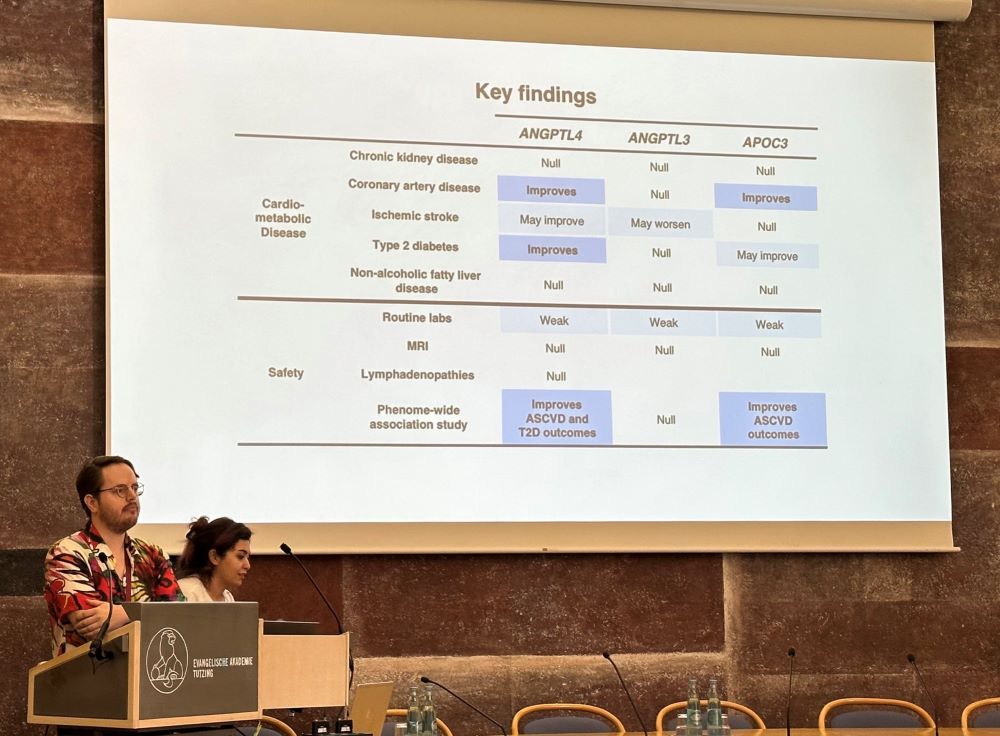Genetic validation of ANGPTL4 as a target protein
2023-12-18
Lipigon's Clinical Scientist Fredrik Landfors's research provides strong scientific support for targeting drugs towards ANGPTL4, the target protein for Lipisense®. Central to the work is genetic validation. Here, he shares more about what it is and what it means for Lipigon.
Lipisense® is Lipigon's most advanced project, aiming to reduce blood triglyceride levels in patients with significantly elevated levels. Genetic data reveals that the target protein for Lipisense®, ANGPTL4, is an independent risk factor for cardiovascular disease and type 2 diabetes.
Fredrik Landfors, Clinical Scientist at Lipigon, is an expert within the area and has extensive knowledge of ANGPTL4 as a target protein. Much of his research has examined whether genetic data supports choosing ANGTPL4 as a crucial target to reduce the risk of cardiometabolic diseases by lowering blood fats.
Identifying, validating, and implementing genetic markers or other biomarkers to predict how a drug is metabolized in the body and its potential effects significantly reduces development risk. This is because it allows a more accurate prediction of the drug's functions and potential impact.


Higher chanse of success
“Today, only about one in eight drugs entering a phase I trial achieves the desired outcomes in phase III trials, such as improved quality of life, reduced mortality, or decreased recurrence. Researchers may observe positive effects on a biologically disease-associated marker, such as a protein in the blood, early in development. However, it may not ultimately benefit the patient since disease processes involve countless unknown parameters”, says Fredrik Landfors.
Factors such as mistimed disease progression, unknown mechanisms, and unforeseen side effects that overshadow potential benefits can come into play.
In contrast, drugs targeting genetically validated targets have 2-4 times higher chances of yielding positive effects for patients. This means the likelihood of a drug candidate progressing from phase I to completion increases from 12.5% to 25–50%.
“Focusing on genetically validated targets exposes our patients to fewer investigational drugs that prove ineffective. From an economic standpoint, this significantly reduces the risk, notes Fredrik Landfors.
Genetically validated target protein
What does genetically validated target protein mean? And why can genetic validation predict which drugs will work?
Preclinical development, meaning before phase I, is often based on animal models and cell experiments in a laboratory environment. These models often represent only parts of human disease progression and are, therefore not entirely translatable. One way to strengthen the argumentation is through genetic studies.
"Drug candidates to be tested in humans must, of course, be thoroughly evaluated, and the better we understand the candidates target protein, the better chance we have of conducting good clinical studies. Genetics help us screen target proteins for humans more easily, without conducting early clinical drug trials."
Most humans share most gene variants, and each person's genetic makeup consists of three billion base pairs. Approximately 30 million of these, i.e., one percent, encode the 20,000 proteins in the body. Before each new fertilization, some of these base pairs will change, meaning the genes have 'mutated' before being passed on to the next generation.
"Most of the time, it is negligible, but sometimes it can lead to the replacement of protein-coding base pairs, causing the protein to wholly or partially lose its function. Sometimes, such gene variants lead to disease, but they can occasionally lead to decreased disease. These variants can be used as a genetic surrogate for the drug. If a reduction in the target protein through a genetic change protects against disease, it is also more likely that a reduction through drugs will have protective effects," says Fredrik Landfors.
Multiple studies validate ANGPTL4
Fredrik and colleagues have conducted genetic studies of the blood lipid-lowering target proteins ANGPTL3, ANGPTL4, and APOC3.
"Taking ANGPTL4 as an example, research from our team and other groups shows that natural variation in the ANGPTL4 gene sequence, leading to the loss of the protein's function, can lead to lower triglyceride levels, a decreased chance of developing atherosclerotic heart disease, and a reduced risk of type 2 diabetes”.
Previous studies have also demonstrated improved glucose control during glucose tolerance tests in individuals with a lower proportion of functional ANGPTL4.
"In summary, a substantial reduction in ANGPTL4 is likely to yield similarly positive effects – the chances increase, as mentioned, by 2–4 times," says Fredrik Landfors.
For Lipigon, this means a decrease in development risk and a higher likelihood of reaching its milestones.